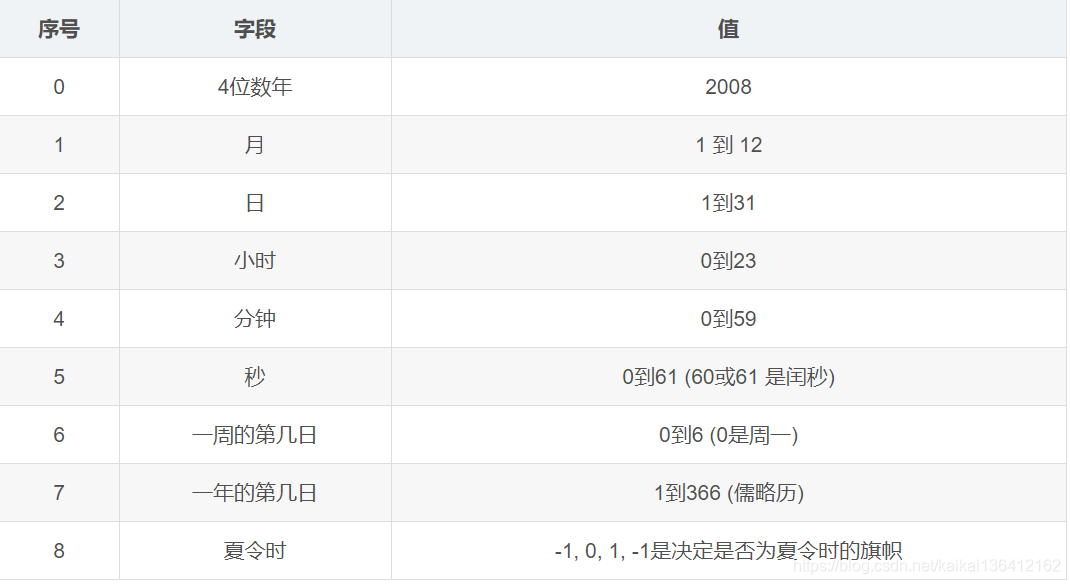感谢邱工提供的文档---------------------
作者:qxq-xq
来源:CSDN
原文:https://blog.csdn.net/qq_23518283/article/details/89006517
版权声明:本文为博主原创文章,转载请附上博文链接!
Python round() 函数
round() 方法返回浮点数x的四舍五入值。
语法
round( x [, n] )
参数
1. x – 数字表达式。
2. n – 表示从小数点位数,其中 x 需要四舍五入,默认值为 0。
返回值
返回浮点数x的四舍五入值。
#!/usr/bin/python3
print("round(12.56789) : ", round(12.56789))
print("round(12.123, 1) : ", round(12.123, 1))
print("round(34.561, 2) : ", round(34.561, 2))
print("round(111.000099, 3) : ", round(111.000099, 3))
print("round(111.000999, 3) : ", round(111.000999, 3))
print("round(-111.000099, 3) : ", round(-111.000099, 3))
print("round(-111.000999, 3) : ", round(-111.000999, 3))
# 输出结果:
round(12.56789) : 13
round(12.123, 1) : 12.1
round(34.561, 2) : 34.56
round(111.000099, 3) : 111.0
round(111.000999, 3) : 111.001
round(-111.000099, 3) : -111.0
round(-111.000999, 3) : -111.001
python time模块、datetime模块,格式相互转换
什么是时间元组?
很多Python函数用一个元组装起来的9组数字处理时间:

上述也就是struct_time元组。这种结构具有如下属性:

import time
import datetime
# 每个时间戳都以自从1970年1月1日午夜(历元)经过了多长时间来表示。
now_time = time.time()
print('时间戳:', now_time)
# 秒级时间戳
second_time = int(now_time)
print('秒级时间戳:', second_time)
# 毫秒级时间戳
print('毫秒级时间戳:', int(round(now_time * 1000)))
# 毫秒级时间戳,基于lambda
t = lambda: int(round(now_time * 1000))
print('毫秒级时间戳,基于lambda:', t())
# 微秒级时间戳
print('微秒级时间戳:', int(round(now_time * 1000*1000)))
# now([tz]) 不指定时区,返回一个当前本地时间的datetime.datetime类的对象
# 指定时区,返回指定时区的时间
date_now = datetime.datetime.now()
print('now:', date_now, type(date_now))
# today函数 返回一个当前本地时间的datetime.datetime类的对象。
date_today = datetime.datetime.today()
print('today:', date_today, type(date_today))
# 日期时间格式化,datetime.datetime类的对象转换为指定格式的字符串
format_time_str = date_now.strftime('%Y-%m-%d %H:%M:%S')
print('日期时间格式化:', format_time_str, type(format_time_str))
# strptime("时间字符串", format) 将格式时间字符串转换为datetime对象
format_time = datetime.datetime.strptime(format_time_str, '%Y-%m-%d %H:%M:%S')
print('字符串日期时间格式化:', format_time, type(format_time))
# 将日期转为秒级时间戳
time_stamp = int(time.mktime(time.strptime(format_time_str, "%Y-%m-%d %H:%M:%S")))
print('将日期转为秒级时间戳', time_stamp)
# 时间元祖或时间数组(9), struct_time
now_struct = time.localtime(second_time)
print('时间元祖:', now_struct)
# 时间字符串转为时间元组
timeArray = time.strptime(format_time_str, "%Y-%m-%d %H:%M:%S")
print('时间元祖:', timeArray)
# 时间元祖可以调用其9个属性
# (tm_year, tm_mon, tm_mday, tm_hour, tm_min, tm_sec, tm_wday, tm_yday, tm_isdst)
tm_year = timeArray.tm_year
print('tm_year:', tm_year)
# 将秒级时间元祖转为字符串日期
date_time = time.strftime("%Y-%m-%d %H:%M:%S", time.localtime(second_time))
print('秒级时间元祖转为字符串日期:', date_time, type(date_time))
# fromtimestamp(timestamp[,tz]) 给定一个时间戳,返回指定时区的datetime.datetime类的对象。不指定时区,返回本地时区的datetime类对象
date_now = datetime.datetime.fromtimestamp(time_stamp)
print('秒级时间戳转日期:', date_now, type(date_now))
# Datetime类year、month、day、hour、minute、second属性
now_year = date_now.year
print('当前年:', now_year)
now_month = date_now.month
print('当前月:', now_month)
now_day = date_now.day
print('当前日:', now_day)
now_hour = date_now.hour
print('当前时:', now_hour)
now_minute = date_now.minute
print('当前分:', now_minute)
now_second = date_now.second
print('当前秒:', now_second)
输出结果:
时间戳: 1554297769.87987
秒级时间戳: 1554297769
毫秒级时间戳: 1554297769880
毫秒级时间戳,基于lambda: 1554297769880
微秒级时间戳: 1554297769879870
now: 2019-04-03 21:22:49.879940 <class ‘datetime.datetime’>
today: 2019-04-03 21:22:49.879996 <class ‘datetime.datetime’>
日期时间格式化: 2019-04-03 21:22:49 <class ‘str’>
字符串日期时间格式化: 2019-04-03 21:22:49 <class ‘datetime.datetime’>
将日期转为秒级时间戳 1554297769
时间元祖: time.struct_time(tm_year=2019, tm_mon=4, tm_mday=3, tm_hour=21, tm_min=22, tm_sec=49, tm_wday=2, tm_yday=93, tm_isdst=0)
时间元祖: time.struct_time(tm_year=2019, tm_mon=4, tm_mday=3, tm_hour=21, tm_min=22, tm_sec=49, tm_wday=2, tm_yday=93, tm_isdst=-1)
2019
秒级时间元祖转为字符串日期: 2019-04-03 21:22:49 <class ‘str’>
秒级时间戳转日期: 2019-04-03 21:22:49 <class ‘datetime.datetime’>
当前年: 2019
当前月: 4
当前日: 3
当前时: 21
当前分: 22
当前秒: 49strptime判断字符串是否为日期格式、判断生日日期格式是否正确
注意:
time.strptime(str_date, “%Y-%m-%d”),其本质是将日期字符串转换为时间元祖,如果格式不匹配就会报错,需要配合try使用
import time
def is_valid_date(str_date):
"""判断是否是一个有效的日期字符串"""
flag = False
try:
if ":" in str_date:
time.strptime(str_date, "%Y-%m-%d %H:%M:%S")
else:
time.strptime(str_date, "%Y-%m-%d")
flag = True
except:
pass
try:
if ":" in str_date:
time.strptime(str_date, "%Y/%m/%d %H:%M:%S")
else:
time.strptime(str_date, "%Y/%m/%d")
flag = True
except:
pass
return flag
def is_valid_date(str_date):
"""判断生日日期格式是否正确"""
flag = False
try:
if "-" in str_date:
time.strptime(str_date, "%Y-%m-%d")
else:
time.strptime(str_date, "%Y/%m/%d")
flag = True
except:
pass
return flag
datetime 模块之timedelta
timedalte 是datetime中的一个对象,该对象表示两个时间的差值
构造函数:datetime.timedelta(days=0, seconds=0, microseconds=0, milliseconds=0, minutes=0, hours=0, weeks=0)
其中参数都是可选,默认值为0
1 millisecond = 1000 microseconds
1 minute = 60 seconds
1 hour = 3600 seconds
1 week = 7 days
在构造函数中,参数值的范围如下:
0 <= microseconds < 1000000
0 <= seconds < 3600*24 (the number of seconds in one day)
-999999999 <= days <= 999999999
timedalte 有三个只读属性:
timedelta.min:负数最大时间差,相当于 timedelta(-999999999)。
timedelta.max:正数最大时间差,相当于 timedelta(days=999999999, hours=23, minutes=59, seconds=59, microseconds=999999)。
timedelta.resolution:两个时间的最小差值 相当于 timedelta(microseconds=1)。
timedelta.total_seconds()方法:返回该时间差 以秒为单位的值
import time
import datetime
a = datetime.datetime.now()
time.sleep(5)
b = datetime.datetime.now()
c = b - a
print(c, type(c))
d = c.total_seconds()
print(d, type(d))
a_str = a.strftime('%Y-%m-%d %H:%M:%S')
a_time = datetime.datetime.strptime(a_str, '%Y-%m-%d %H:%M:%S')
b_str = b.strftime('%Y-%m-%d %H:%M:%S')
b_time = datetime.datetime.strptime(b_str, '%Y-%m-%d %H:%M:%S')
c_timedelta = b_time - a_time
print(c_timedelta, type(c_timedelta))
d_seconds = c_timedelta.total_seconds()
print(d_seconds, type(d_seconds))
d_seconds_int = int(d_seconds)
print(d_seconds_int, type(d_seconds_int))
输出结果:
0:00:05.001459 <class ‘datetime.timedelta’>
5.001459 <class ‘float’>
0:00:05 <class ‘datetime.timedelta’>
5.0 <class ‘float’>
5 <class ‘int’>
时间差:datetime.timedelta()
参数days=0, seconds=0, microseconds=0, milliseconds=0, minutes=0, hours=0, weeks=0
a = datetime.datetime.now()
a_str = a.strftime('%Y-%m-%d %H:%M:%S')
a_time = datetime.datetime.strptime(a_str, '%Y-%m-%d %H:%M:%S')
print(a_time)
one_day = datetime.timedelta(days=1)
one_hour = datetime.timedelta(hours=1)
print(one_day)
print(one_hour)
yestoday = a_time - one_day
print(yestoday)
输出结果:
2019-04-03 22:14:16
1 day, 0:00:00
1:00:00
2019-04-02 22:14:16
注意:
拼接日期时有时需要判断当前的日期是否是1号,如果是需要做特殊处理,如下方代码
now_date = datetime.datetime.now()
one_day = datetime.timedelta(days=1)
yesterday_data = now_date - one_day
if now_date.day == 1:
next_date = datetime.datetime(yesterday_data.year, yesterday_data.month, yesterday_data.day, 17, 0, 0)
else:
next_date = datetime.datetime(now_date.year, now_date.month, yesterday_data.day, 17, 0, 0)
next_date_str = '2019-04-03 23:03:03'
next_date = datetime.datetime.strptime(next_date_str, '%Y-%m-%d %H:%M:%S')
i_hour = datetime.timedelta(hours=1)
next_date = next_date + i_hour
print(next_date) # 2019-04-04 00:03:03
next_date_str = '2019-04-03 00:03:03'
next_date = datetime.datetime.strptime(next_date_str, '%Y-%m-%d %H:%M:%S')
i_hour = datetime.timedelta(hours=1)
next_date = next_date - i_hour
print(next_date) # 2019-04-02 23:03:03